ISIS slit width temperature dependence
Introduction
In February 2012 the 4MS system controlling the ISIS instrument was replaced
by a PLC (Programmable logic controller) system that is integrated to the existing
instrument control system. Due to the new PLC controllers, among others, a
new absolute zero point of the ISIS slit width had to be defined. During a
preparation work for new PLC controllers and a definition of new ISIS slit-width zero
point, the dependence of the ISIS slit width on the temperature was noticed for
the first time. Only during 2012 the dependence became more obvious with
more measurements made at different telescope temperatures, but results
showed some outliers from the linear trend dependency. At that time, we had
only telescope truss temperature (TEMPTUBE) available from the image headers and we
actually did not know the temperature inside the ISIS slit assembly, which could have
been an explanation for the outlier measurements. After the ISIS is mounted to
the telescope it can take up to several days for the temperature inside ISIS to
equalize with the ambient temperature inside the dome, and during this time
we could not relate the ISIS slit-width dependence with the actual temperature
inside ISIS.
In order to confirm the dependence of ISIS slit width on the temperature a
new temperature sensor was mounted in January 2013 close to the ISIS slit unit (see picture below).
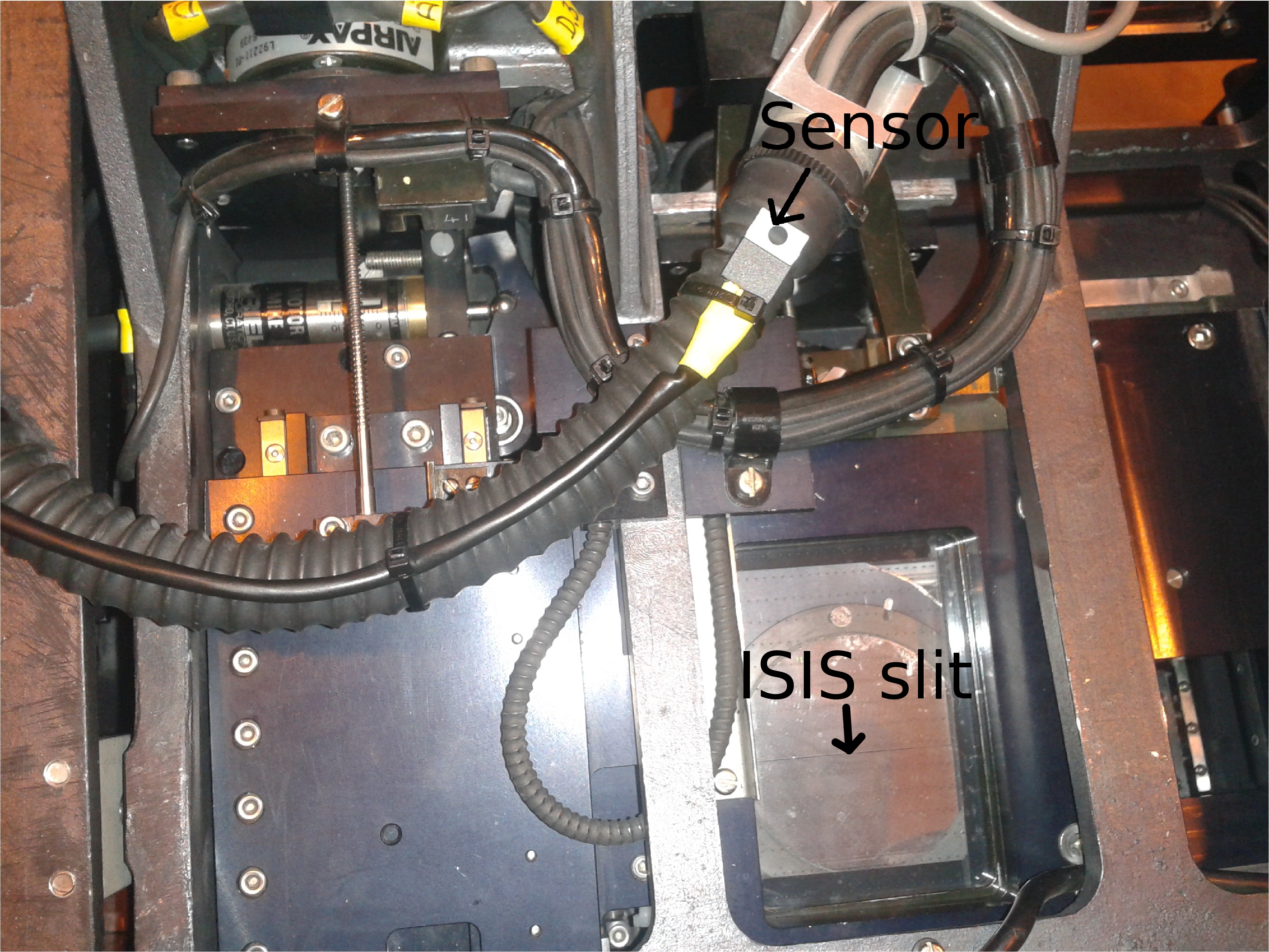
The temperature sensor readings are saved in PLC interface and labeled as
Instrument_Temperature (see picture below).
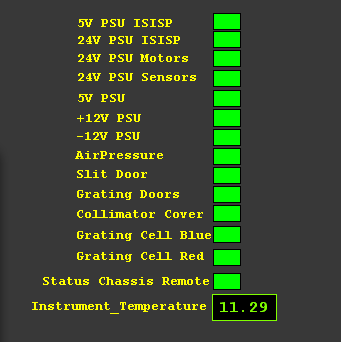
The origin of the slit-width dependence on the temperature was investigated,
to exclude the possibility that this behavior is caused by PLC
controllers. We checked many arcs from 2011 and compared the expected versus
measured resolution in relation with the telescope truss temperature from
the image headers. Interestingly, the dependency of the ISIS slit width on temperature
is also apparent except of few measurements which most of them were taken on
the day when ISIS was mounted to the telescope or up to two days afterwards. Thus we
can exclude that PLC controllers are the cause of this temperature dependence.
Measurements
To measure the actual value of the slit width at given temperature we took a
series of tungsten lamp flat fields, all with the same exposure time, and
slit width ranging from 3 to 0.4 arcsec. From each flat a mean bias level was subtracted. We checked
that overscan region correction did not have any influence on the resulting
flux level of our flat fields, and thus this correction was not applied. We
measured a mean level of flux in each flat in two different regions, and
we plotted this flux versus
demanded slit width (the one shown in
headers). We then fitted a linear trend, and the intersection of the fit
with x axis is the
actual slit-width offset (SWO) with respect to the
demanded slit-width position. To get the final value of the actual slit
width offset for each temperature, we made an average of values coming from
two different regions. These two values were always consistent and very similar to each other, which is also
an independent check of our measurements. An example of such a fit is shown
in the figure below, where the interception of both linear fits with x axis is 0.102 arcsec. This means that the actual
slit width was 0.102 arcsec smaller than demanded slit width, i.e. less flux than
expected is coming through the slit. The telescope truss
temperature was 3.39 deg and the instrument temperature was 5.54 deg during
the measurements shown in the figure below.
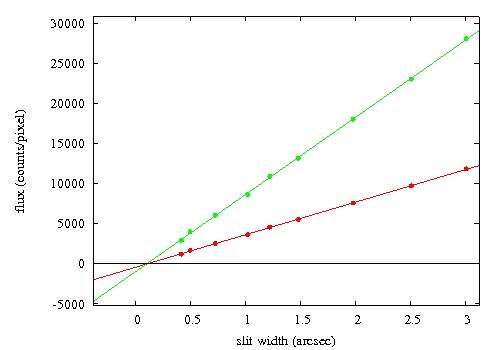
Results
From each series of flats we obtain one value of the SWO between the absolute and demanded slit width.
The dependence of the SWOs versus temperature based on measurements in different days and times of
the year is plotted in the figure below. It is apparent that only for temperatures
colder than 10.9 deg the slit is in fact narrower than expected, and for
temperatures hotter than 10.9 deg we do not see any such behavior. In the
figure the red line is the linear fit to points with temperature less than 10.9 deg
(red dots), and the green line is the constant fit to points with temperature more than 10.9 deg
(green dots). Individual measurements can be found in Table below, where
also a telescope truss temperature (TEMPTUBE) is shown for a comparison.
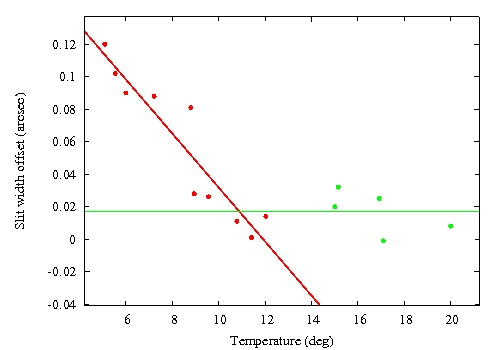
Measurements of ISIS slit width offset (SWO) |
Date |
TEMPTUBE |
Instrument_Temperature |
SWO |
|
deg |
deg |
arcsec |
20120620 |
12.8 |
|
0 |
20121230 |
8.3 |
|
0.05 |
20130201 |
9.68 |
10.78 |
0.016 |
20130209 |
5.98 |
7.22 |
0.093 |
20130212 |
7.76 |
8.8 |
0.086 |
20130318 |
5.48 |
8.95 |
0.033 |
20130323 |
3.39 |
5.54 |
0.107 |
20130323 |
4.56 |
6.00 |
0.095 |
20130324 |
3.03 |
5.09 |
0.125 |
20130326 |
8.58 |
9.56 |
0.031 |
20130330 |
11.05 |
11.41 |
0.006 |
20130331 |
10.13 |
12.03 |
0.019 |
20130615 |
14.63 |
15.01 |
0.025 |
20130616 |
14.46 |
15.16 |
0.037 |
20130824 |
19.79 |
20.00 |
0.013 |
20130825 |
14.79 |
16.92 |
0.030 |
20130825 |
15.97 |
17.10 |
0.004 |
Implementation of the correction
As of 2nd December 2013, the slit width offset (SWO) is applied to the slit
width using a linear fit or a constant offset, as presented in section
Results, and depending on the temperature inside the
ISIS slit unit = Instrument_Temperature (see
Introduction).
The correction for the SWO takes place every time when the slit width
change is requested, or a new command for setting the slit width is
issued, e.g.:
SYS@taurus> slitarc 1
The Instrument_Temperature is implemented in ISIS Mimic, so that the observer
can monitor the temperature during the run and issue the new slit width command if needed,
i.e. if the temperature changes by considerable amount. The quick temperature changes by
several degrees may happen e.g. in winter when ISIS is moved from the telescope
focal station to the cold dome and it takes several days for the temperatures to
equalize.
Since 2nd December 2013 there are also two new header keywords in ISIS fits
headers:
SLITEMPL= '10.21 ' / Slit unit temperature last (Celsius)
SLITEMPA= '10.21 ' / Slit unit temperature Average (Celsius)
SLITEMPL is simply the last temperature reading of the
Instrument_Temperature. The new value is read every 10 s.
SLITEMPA is calculated using the following: SLITEMPA=0.9 * SLITEMPA + 0.1 * SLITEMPL
In order to avoid the slit width mechanism being stacked at very low values,
the lowest possible value for the slit width was defined as 70 microns,
which equals to 0.32 arcsec. Given the pixel scale of 0.2 and 0.22
arcsec/pixel for the EEV12 and REDPLUS CCDs, respectively, this limitation
is not a problem for observations.
During December 2013 and January 2014 we did several tests to check the
performance of the slit width correction. Each time, we took data as described
above in the section Measurements, for both slit width temperature
correction applied and not applied. The example can be seen
at the figure below, which is zoomed in for better clarity.
The red (blue) points are measurements with (without) a temperature correction applied,
and red and blue lines are corresponding fits to the data. The red fit gives a slit
width offset of 0.021 arcsec, whereas the blue fit 0.141 arcsec. The
temperature during the measurements was 4.7 deg, thus a correction of 0.12
arcsec was applied by the software. This nicely agree with the observed
difference of 0.12 arcsec between the corrected and uncorrected data, which
is really re-assuring. We conclude that the slit width temperature
correction is working well, and even though there are residuals (e.g. 0.021
instead of 0 arcsec slit width offset) they are much smaller than in a past.
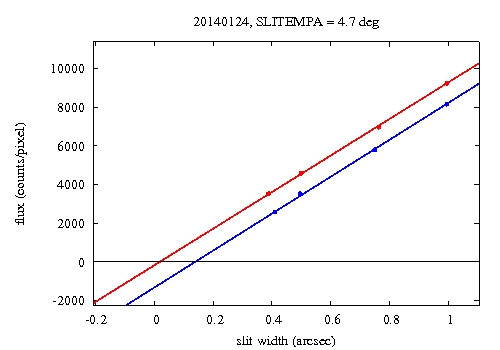
Troubleshooting
ISIS Mimic shows 'Error' for both temperatures:
Probably the communication with the PLC has been interrupted. In this
scenario you will probably see other ISIS related errors in the Mimic.
ISIS Mimic does not refresh the temperature values:
It could happen that the software reading the Instrument_Temperature has
been killed for any reason. In the instrument control system, type:
SYS@taurus> IsisSlittempPublisher restart
The engineering guide containing more details about the software reading
the Instrument_Temperature can be found
here.












